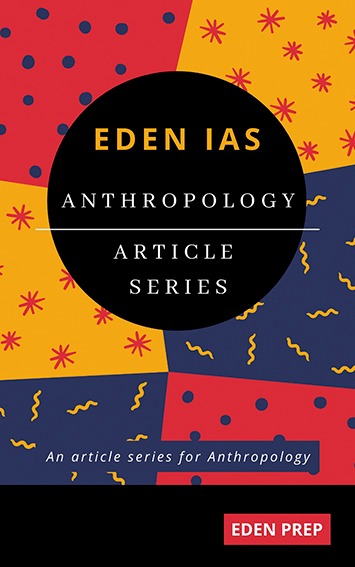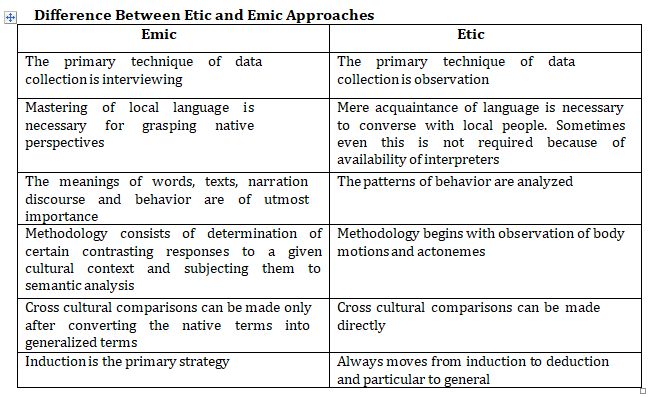
EDEN BLOGS
COGNITIVE ANTHROPOLOGY
18
May


(Anthropology Paper I)
Syllabus Section: 6. Anthropological Theories
Introduction:
- Cognitive Anthropology studies culture as an ideational system, as a system of knowledge which is embedded in words, stories and in the artifacts which is learned from and shared with other humans. It describes, analyzes and interprets the workings of the human mind.
- Cognitive anthropology is an idealist approach to studying the human conditions. This field focuses on the study of the relationship between human culture and human thought.
- In contrast to some earlier approaches, C/A does not regard culture as material phenomenon but rather cognitive organization
- It studies how people understand and organize material objects, events and experiences
- It is an approach that stresses upon how people make sense of reality according to their own indigenous cognitive categories, not those of the anthropologist
- The goal of CA is to arrive at a description and analysis of culture as a member of that culture would see it, free from the biases of an outside/anthropologist
Background/History
- It is a recent development in the field of anthropology. Its roots, however, go back to the works of early anthropologists
- Tylor says “It is futile to measure one’s own corn in another’s bushel”
- Franz Boas says that a culture should be studied in its own terms
- Malinowski says that the ethnographer must grasp the natives’ point of view about their culture
- The desire to include people’s point of view about culture had become so strong that it had given rise to a movement in 1950’s in Yale University called New Ethnography.
- In New Ethnography the cultural items and relationships were described in their own linguistic categories.
- The efforts of the movement fructified when some anthropologists started studying ethno semantics and the knowledge structures of different societies
- In 1970s decision-making models and narrative grammars were added to cognitive studies.
- In 1980s methods were developed in discourse semantics, in mapping of consensus in knowledge and belief among natives and in application of artificial intelligence to the study of knowledge in ethnography
- In 1990s were added cognitive theories of emotion, study of linkage of cognitive and emotional process to health, religious symbolism etc.
- In 1955, Kenneth Pike proposed a method for the study of people’s categories of culture. He coined the terms Emic and Etic as the methods of cultural anthropology and traditional ethnography respectively. Words taken from linguistics – Phonetics and Phonemics. He suggested the Emic method for the study of insider’s viewpoint of culture
- In many ways, C/A was a reaction against the traditional methods of ethnology prior to 1950s, much of it, the result of the influence of fieldwork pioneers, Malinowski and Boas.
- As more and more scholars entered the field, it was found that the ethnographies of places revisited did not always match the ethnographies of a previous generation.
- These conflicting ethnographic accounts raised the question of validity – to what extent could any ethnography be trusted?
- The problem of validity was first tackled through linguistics (etic and emic)
- The discovery of the phoneme, the smallest unit of a meaningful sound, gave anthropologists the opportunity to understand cultures in the native language.
- This was a way of getting around the analyst’s imposition of his own cultural bias on a society. This led to an approach known as Ethnoscience / New Ethnography
- The scope of CA is vast and includes broadly the study of Semantics, Knowledge Structures, Models and Systems Analysis and Discourse Analysis
- Much of the development of C/A can be traced to Floyd Lounsbury and Ward Goodenough
- The notable of this is Goodenough’s Componential Analysis in 1956 where he laid out the basic premises for New Ethnography
- He states that culture is a conceptual mode underlying human behavior in that it refers to the standards for deciding what one feels about something, how to go about doing it
- No longer was a simple description of what was observed by the ethnographer sufficient
The new aim was to find the underlying meaning behind the people’s conception of the world around them
Accomplishments
- It provides detailed and reliable description of cultural representations
- It has helped to provide a bridge between culture and functioning of human mind
- It has helped reveal some of the inner workings of the human mind, and given us a great understanding of how people order and perceive the world around them
- The most notable contribution is its development of cultural methodologies that are valid and reliable representation of human thought
Criticism
- According to Keesing, the so called “New Ethnography” was unable to move beyond the analysis of artificially simplified and often trivial semantic domains
- Ethno-scientists tended to study phenomena without being able to elucidate their relevance to understanding culture as a whole
- There is not a way in which the findings of Ethno science can be applied to other cultures
- C/A deals with abstract theories regarding the nature of mind. While there have been a plethora of methods for accessing culture contained in mind, questions main about whether results in fact reflect how individuals organize and perceive society or whether they are merely manufactured by investigators, having no foundation in their subject’s reality
- Universal agreement on how to find the culture in the mind has yet to emerge. When one compares the works of major figures in the field, it is clear they each have a different idea about just how to pursue the goals of the field.
- When approaching an issue as complex as the human mind, mental processes and culture, it is salutary to seek a multifaceted convergence, which is missing amongst these scholars But still, C/A holds much promise for the future of cultural analysis.


{{doubts.user.firstName}}
{{doubts.createdAt | formatDate}}